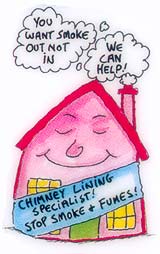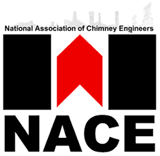Chimney Lining
Types of linings and reasons for lining.
New properties being built these days have chimneys built with clay liners installed. This can be a costly undertaking and should be carried out correctly to eliminate further costs. These liners are rebated and should be fitted with the socket uppermost and the Spigot looking down. Occasionally this type of chimney is not built to specification. Many are built using lime mortar to bond the clay liners and infill around the liner could be rubble mixed with mortar also the clay liners may be fitted upside down. The correct angled liners are not used where the liners may be cut at an angle to achieve a bend
This type of construction would inevitably result in the seepage of condensates and moisture and as a result staining of walls and internal decoration; it could also result in the leakage of smoke/fumes,
The correct method of installation would be to install the correct angled liners, lightweight insulation surrounding the liner and the clay liner jointed using an acid resistant jointing compound (Non combustible) any compound squashed out of the joints must be removed leaving a smooth circular chimney.
(See Eldfast Lining )
The most efficient chimney would be a vertical one with the least amount of bends. The straighter the flue the less resistance for the fumes/smoke to flow. Flue block systems are also used and should be installed to manufacturer specification. Existing brick built chimneys may start leaking fumes/Smoke. This could be as a result of wear and tear or possibly a recent chimney fire. A survey would then be carried out by a chimney engineer. This could result on a Smoke test being carried out or an inspection with a chimney camera. (See Camera survey)
A report can then be submitted with the findings. A decision then has to be made as to what remedial works can be carried out to eliminate this leakage. For Solid fuel open fires the Cast in Situ concrete lining would be an option. A cheaper option would be a semi flexible Stainless steel liner. If there is a Solid fuel appliance fitted (Stove) both above types of linings can be used but would be smaller in diameter, the reason for this would be to keep the temperature of the fumes hotter, this would inevitably reduce the condensates produced by the cooling off of the smoke/fumes. Appliances with back boilers and/or left in a slumbering mode are more vulnerable to the tar/condensate build-up as the boiler assists in the cooling off. Reducing the diameter of a chimney for a solid fuel appliance is recommended in most cases to achieve the up most efficiency of the appliance. Old chimneys are mostly large in size and irregular shapes which hinder the fumes/smoke as they rise in turn making the appliance sluggish and difficult to keep a constant temperature.
Occasionally a partial collapse of the chimney is encountered; this could be the wear and tare of the midfeather wall (wall separating two flues)
This should be re- built prior to any form of lining takes place.
After chimney linings have been carried out consideration should be given to the type of terminal, There are many types on the market, These could be of a revolving type to increase draw on the chimney. Another type could be to eliminate blow back in certain weather conditions, Possibly a cowl to deter vermin from entering the chimney or to reduce/eliminate rain ingress, Certain clay Chimney pots can be fitted to serve the same purpose, This is generally discussed with the client prior to purchasing any of the above items.
Maintenance.
When any form of chimney lining is installed many feel there is no need to sweep the chimney, this should be carried out by a registered chimney sweep at least annually in many cases twice a year depending on the fuel being used. An un-cleaned chimney causes various problems, Poor draw on the chimney so the appliance will not perform correctly, this would inevitably cause a Chimney fire which could damage the lining. If a chimney fire is experienced the lining should be checked for any damage and could result in remedial work being carried out which could be more costly than sweeping as recommended.


